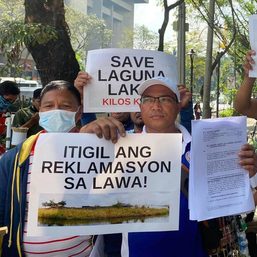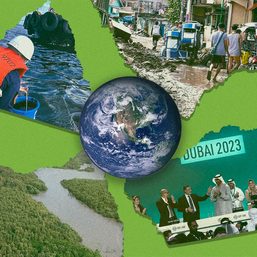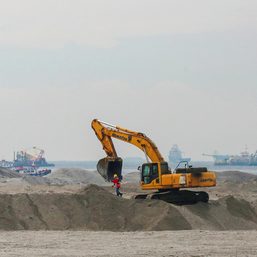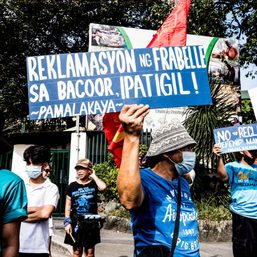SUMMARY
This is AI generated summarization, which may have errors. For context, always refer to the full article.

First of 2 parts
Part 2: Philippine reclamations: How business and nature collide
MANILA, Philippines – The Philippines currently has over 180 proposed and ongoing reclamation projects that promise economic boom for urban and rural communities nationwide – almost double the number of targeted dump-and-fill ventures a decade ago.
But as the seas, mangroves, and coastal folk are routinely displaced by malls, airports, and residential districts, data on the real economic and social impacts of Philippine reclamations remain hidden and unstudied.
For these reasons and amid a climate crisis that is increasing Filipinos’ vulnerabilities, environmentalists and advocates are lobbying for changes in the country’s reclamation laws and policies. These include increased and genuine public transparency in projects, given the recurring lack of data, which, they say, makes it all too difficult to challenge the highly divisive practice.
In this two-part series, Rappler mapped and analyzed available data on past, current, and potential Philippine reclamation projects and found that while reclamations are increasingly backed by national and local governments working with business firms and corporations, the system regulating reclamations has yet to catch up with the spread of the practice.

Visuals of progress
Reclamation or dump-and-fill projects involve the conversion of bodies of water into land to set the stage for commercial, industrial, leisure, and residential establishments.
Leon Dulce, former national coordinator of environmental activist group Kalikasan, said that modern and multibillion-peso reclamation projects are often pitched as economic boosters that create thousands of jobs and investment opportunities for the country.
But scientists and environmentalists oppose this practice for its adverse and permanent effects on natural resources and communities, such as shelter and job displacements, food insecurity, and exacerbation of calamities, to name a few. Dulce added that these losses are tough to translate into numbers – a gap that needs to be filled to better understand the socioeconomic impacts of reclamations.
Archaeologist Vito Hernandez, who did excavations in Manila, explained that the practice of reclamation dates as far back as the Spanish and American colonial eras, based on gathered and dated geo-archaeological data. Some of these projects include Intramuros, North Harbor, Roxas Boulevard, and parts of Ermita and Malate.
"Reclamation brought in a gentrification at a shift in the culture," Hernandez said of the many reclamations during the American period. "Who did we displace? Where did the fisherfolk go? Where did our environment go? Those are the questions that are not asked because [what we see is the] obvious."
Reclamation projects in Manila continued under the Philippine republic. One of the most prominent yet contentious works is the Cultural Center of the Philippines (CCP) Complex, a political pet project of the convicted former first lady Imelda Marcos.
Marred by corruption scandals and abuse of state machinery under dictator Ferdinand Marcos' regime from the late 1960s to the early 1980s, the CCP Complex in Manila Bay plunged the Philippines into deep debt, as detailed in Gerard Lico's Edifice Complex.
In the book, architect and heritage conservation professional Lico wrote that building the CCP structures also cost environmental resources and even human lives: 169 construction workers – based on labor groups' records – died when the Manila Film Center, whose construction was rushed, collapsed in 1981.
Another reclamation project behind the CCP Complex that was never completed was later on developed to host major real estate projects. Known as the Boulevard 2000 or Centennial City project, spearheaded under former president Fidel Ramos' administration in the 1990s, this reclamation venture became controversial after the Public Estates Authority (PEA) unconstitutionally sold public land to the foreign Amari Corporation. The PEA – now the Philippine Reclamation Authority (PRA) – and other politicians allegedly earned illegal commissions from the notorious deal dubbed as "the grandmother of all scams."
A decade after, the People's Network for Integrity of Coastal Habitats and Ecosystems or People's NICHE – which has been monitoring reclamations in the country – said that the administration of the late former president Benigno Aquino III had proposed a National Reclamation Plan that targeted 102 projects during his term.
Although this idea was eventually shelved due to public pressure, the number of dump-and-fill projects has risen in recent years, Dulce said, due to the continuous executive push for reclamations as part of the country’s development agenda.
Development for whom?
Fernando Hicap, who has been a fisherman all his life and has witnessed reclamations since the 1970s, pointed out that despite the promise of progress these dump-and-fill projects offer, there have been no studies on their real economic impacts.
Hicap, also a longtime chairperson of national small fisherfolk federation Pambansang Lakas ng Kilusang Mamalakaya ng Pilipinas (Pamalakaya), said of privatized reclamations: "Kung naglikha man ng trabaho diyan, ano'ng klaseng trabaho ang meron? Karamihan ng manggagawa diyan ay kontraktuwal. Walang security of tenure, walang benefits."
(If indeed reclamations generated employment opportunities, what kind of jobs were made available? Most of the workers in privatized establishments are contractual. They don't have security of tenure and benefits.)
Through a freedom of information request, the National Economic and Development Authority confirmed to Rappler that to date, it has neither studies nor data on the economic contribution of the completed reclamation projects in the Philippines.
Transparency issues
But even with the absence of data needed to understand the genuine benefits of reclamations, PRA records suggest there still has been an increased interest in the venture.
As of February 2022, there are 187 projects on PRA's official record: 10 are for implementation – 8 in Luzon and 2 in the Visayas – 3 are approved for the signing of memoranda of agreement, 10 are in the detailed engineering stage, and 164 are still undergoing application to reclaim.
Last April, two months before leaving office, former president Rodrigo Duterte called on the Department of Environment and Natural Resources (DENR) to stop processing applications, calling reclamation activities a hotbed of corruption.
Despite such public proclamations against dump-and-fill works, Dulce believes that reclamation efforts in the country never lost momentum. He thinks these statements have been a strategy to divert public attention from the criticisms against reclamations such as supposed railroading of projects and the lack of genuine consultations with communities – issues further exacerbated by COVID-19 restrictions during the past couple of years.
These transparency issues, as well as procedural irregularities, have been a constant source of dispute in the reclamation space between proponents such as local governments and businesses, and affected communities – even in some projects that have been approved for implementation.
Projects spread out
The Manila Solar City Project was first proposed in 1992 by the Manila Goldcoast Development Corporation. Strong citizen opposition not only stopped the initiative from pushing through, but also successfully influenced the then-Manila council to pass an ordinance prohibiting reclamations in Manila Bay.
Almost 20 years later in February 2011, however, Goldcoast was able to reverse this decision. The corporation garnered support for the project that, according to those who opposed it, did not undergo public consultations. Early 2022, the PRA issued permits allowing the start of reclamation works for the 148-hectare development. (READ: The battle for Manila Bay: Citizens rise against reclamation)
Near the Manila Solar City Project is the Pasay 360-hectare Reclamation Project, a joint venture of the Pasay City government and SM Prime Holdings Inc. that is envisioned to be an expansion of the Mall of Asia (MOA) complex.
The MOA is another massively reclaimed area in Manila Bay built in the early to mid-2000s. According to Hicap, who used to fish in the area prior to the reclamation, the project displaced thousands of fisherfolk families and coastal jobs, and destroyed rich environmental features such as mangroves and shellfish.
Neighboring Manila Solar City and the Pasay 360-hectare reclamations is the Pasay Harbor City Reclamation Project, 265 hectares in size, to be developed by Pasay Harbor City Corporation. Members of this consortium include Udenna Development Corporation of Davao businessman and Duterte ally Dennis Uy, China Harbour Engineering Company, and Ulticon Builders Incorporated – a Davao-based contractor proposing another reclamation in Pasay City.
In Cavite, the Bacoor Reclamation and Development Project is a twin of the proposed 100-hectare Diamond Reclamation Project located within the same area, undertaken by the local government with Frabelle Fishing Corporation and Diamond Export Corporation, respectively. These dump-and-fill ventures have been criticized for decimating the livelihoods of Manila Bay fisherfolk and bringing possible harm to the local tahong (mussel) industry.
In 2020, Pamalakaya filed a complaint with the Ombudsman over the Bacoor projects' reclamation of fishponds and mangroves without permits, which is in violation of Philippine environmental laws.
In Palawan, the Coron Bay Development Project, which was endorsed by the local government in 2007, had residents and environmental groups protesting over its damaging activities. It also ignored calls for a consultative dialogue. The reclamation was recently halted after a local civic group – which had among its co-convenors a member of Duterte's campaign team in 2016 – personally appealed to the former president to stop the project.
In Cebu, the 131-hectare Mandaue venture (also known as the Mandaue Global City Project) by Global City Mandaue Corporation, in partnership with the city government, was previously challenged by a resident over reports that a five-hectare mangrove area could have been uprooted.
File a complaint
When asked about the perennial controversies hounding reclamations – environmental destruction and the lack of project transparency, among others – the DENR's Environmental Management Bureau (EMB), in its written response to Rappler, said that public participation processes and mitigation measures are in place under the Philippine Environmental Impact Statement system.
The EMB, the agency in charge of issuing or rejecting environmental permits for dump-and-fill activities, added, "If the public believes that some of the reclamation projects have not been publicly consulted, then they can file a complaint to our office so that we can investigate them and file the appropriate legal action once we have validated these claims."
Lawyer Golda Benjamin, a member of the No to 174 Dumaguete coalition that experienced similar challenges and pushed back against the city's proposed reclamation, explained that these irregularities in dump-and-fill projects thrive due to the country's weak consultation mechanisms and laws on transparency.
The lack of information on the technical side of projects and the level of expertise needed to understand these data also make it difficult for members of civil society to engage on the merits of a reclamation, she added.
Reclamation hot spots
Of the 187 proposed and ongoing reclamations – from mixed-use development to ports and roads – almost half are in the Visayas region (34 projects in Western Visayas, 32 in Central Visayas, and 25 in Eastern Visayas), totaling 91 projects. Only two of these projects have been approved for implementation.
Calabarzon is also looking to be a reclamation hot spot with 27 ventures. The province of Cavite, in particular, is set to host several mixed-use infrastructure projects for commercial, residential, and industrial use, including the controversial Sangley Point International Airport, whose Chinese contractor has been blacklisted by the United States.
Metro Manila, meanwhile, has 19 projects, majority of which are also mixed-use ventures.
More than half of Calabarzon and Metro Manila's combined number of reclamations are specifically located in different parts of Manila Bay, a productive fishing ground covered by a 2008 Supreme Court mandamus for priority cleanup and rehabilitation.
Impact
Over a decade later, Duterte signed an administrative order expediting the rehabilitation and restoration of Manila Bay, and creating a Manila Bay Task Force. He had also repeatedly said that he would not approve massive dump-and-fill projects in the area given their toll on the environment.
PRA records and additional data, however, reveal that many of the approved reclamations in Manila Bay took place under the Duterte administration. Proposed and approved construction works involving malls, entertainment cities, and business centers in the environmentally critical area rose from 19 projects in 2019 to 27 in 2022. To date, six proposals have been given the green light for construction in the bay.
Some of the mixed-use projects have been touted as a response to population growth in the cities, justifying the need to generate more jobs and expand land area for business centers and housing districts.
Hernandez explained that while reclamations are not necessarily bad, studies have shown that these coincide with urban decline. Geo-archaeological data suggest that in Manila, where many reclamation projects are concentrated, flooding has worsened for communities inland.
"[This suggests] we haven't been managing our development projects on shore very well, and [that's] because we don't have a larger overview of [our] histories, society, and environment," he said.
Given the recent Intergovernmental Panel on Climate Change report that highlighted the vulnerabilities of islands and coastal areas, Hernandez said reclamations have become an even more sensitive issue that needs to be carefully studied for the long term.
For Benjamin, this means looking at the data to understand the actual impacts of reclamations and assessing whether or not communities have really benefited from them. This, she said, requires starting a conversation on the indicators of a good and sustainable reclamation – something that is non-existent at the moment.
"I think we owe that to the advocacy. Apart from identifying the negative effect, we should also be putting out indicators on what's worthy," Benjamin said. (To be concluded: Philippine reclamations: How business and nature collide) – Rappler.com
For tips and leads on Philippine reclamation projects – both included and not included in this report – you may send us an email at investigative@rappler.com. #ReclamationWatchPH
Add a comment
How does this make you feel?



































There are no comments yet. Add your comment to start the conversation.